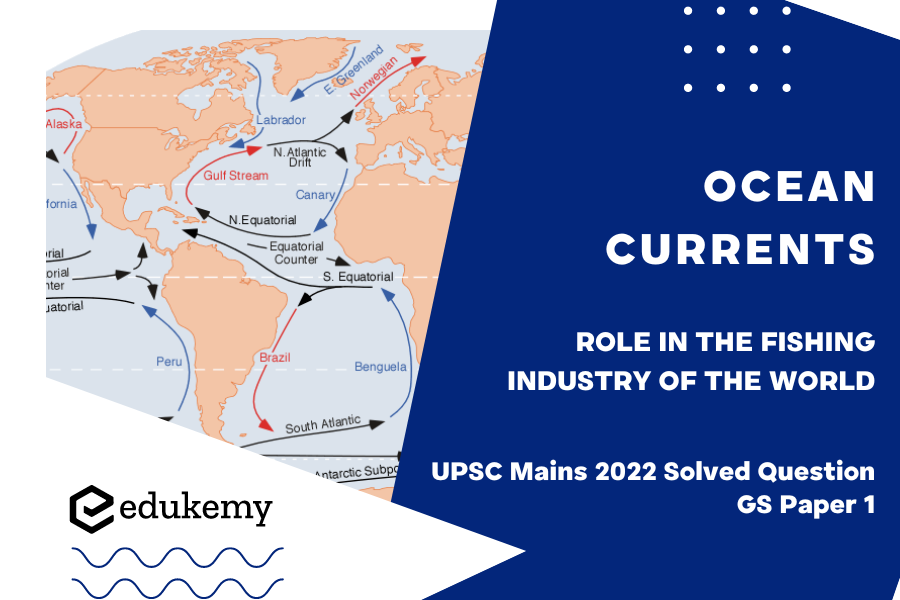Ocean currents are primarily influenced by a combination of factors, with wind, temperature, and the Earth’s rotation playing pivotal roles. Wind, driven by the uneven heating of the Earth’s surface, imparts its energy to the ocean surface, creating surface currents. The Coriolis effect, a result of the Earth’s rotation, deflects these currents to the right in the Northern Hemisphere and to the left in the Southern Hemisphere, giving rise to large-scale circulation patterns.
Temperature also contributes significantly, as warm water is lighter and tends to rise, while cold water is denser and sinks. This temperature-driven vertical movement, known as thermohaline circulation, influences deeper ocean currents. Additionally, the geography of the ocean floor, including underwater ridges and basins, can channel and direct the flow of currents.
The role of ocean currents in the fishing industry is substantial. These currents create nutrient-rich environments that support a thriving marine ecosystem. Upwelling zones, where cold, nutrient-rich water rises to the surface, are particularly important for fisheries. These nutrient-rich waters stimulate the growth of phytoplankton, the base of the marine food chain, attracting a variety of marine organisms. This abundance of marine life in turn attracts fish, making these areas prime locations for fishing.
Fishermen leverage knowledge of ocean currents to strategically position their vessels for optimal catches. Following the flow of currents helps them locate areas with higher fish concentrations, improving the efficiency and success of fishing operations. Conversely, understanding the influence of currents is crucial for avoiding less productive regions, ensuring sustainable fishing practices and the long-term health of marine ecosystems. Overall, the intricate interplay of ocean currents significantly shapes the dynamics of the fishing industry worldwide.
UPSC Mains General Studies Paper – 1 Mains 2022
Factors responsible for the location of primary, secondary, and tertiary sector industries in various parts of the world including India.
UPSC Mains Civil Services IAS Exam Question Paper – 2022
Approach:
- An ocean current flows for great distances and together they create the global conveyor belt, which plays a dominant role in determining the climate of many of Earth’s regions. The currents are generated from the forces acting upon the water- like the earth’s rotation, the wind, the solar radiation, salinity differences in the water, and the gravitation of the moon. The depth contours, the shoreline, and other currents influence the current’s direction and strength. In the fishing industry, ocean currents play a significant role in determining the distribution and abundance of certain fish species.
Body:
The forces that influence the ocean currents:
- Planetary Winds: The wind drives the surface currents of the oceans, pushing the water in a particular direction. The direction of the wind, as well as its strength and duration, determines the direction and strength of the surface currents. Friction is the coupling between the wind and the water’s surface. Example: Trade winds push the Equatorial currents westwards.
- Earth’s rotation: One of the main forces that influence ocean currents is the Earth’s rotation. The Earth’s rotation causes the oceans to bulge at the equator and flatten at the poles, creating a system of currents known as the thermohaline circulation. This circulation helps to distribute heat from the equator to the poles, regulating the Earth’s climate.
- Coriolis force: Coriolis force acts to the right in the northern hemisphere and the left in the southern hemisphere. Hence the circulation of ocean current (GYRE) in the northern hemisphere and southern hemisphere is clockwise and clockwise respectively.
- Solar Heating: Solar heating causes water to expand. Near the equator, the water is about 8 centimeters higher than in middle latitudes. This causes a very slight slope and water wants to flow down the slope.
- Temperature Difference: Temperature is another significant force that influences ocean currents. Warm water is less dense than cold water, so it tends to rise to the surface. This creates surface currents that move warm water away from the equator and towards the poles. Cold water, on the other hand, is more dense than warm water and tends to sink. This creates deep ocean currents that move cold water toward the equator.
- Salinity Difference: Salinity, or the concentration of salt in the water, is another important force that influences ocean currents. When water evaporates, it leaves behind salt, which increases the salinity of the water. This increases the water’s density, causing it to sink and creating deep ocean currents. Areas of high salinity, such as the Mediterranean Sea, can also create surface currents that move water toward areas of lower salinity.
The role of ocean currents in the fishing industry of the world:
- Ocean currents play a crucial role in the fishing industry. The distribution of nutrients and marine life is influenced by ocean currents, which affect where fish are found and how abundant they are in different areas. Some of the most significant ways that ocean currents impact the fishing industry include:
- Upwelling: As mentioned earlier, upwelling is the process by which deep, nutrient-rich water is brought to the surface. This process is essential to the fishing industry, as it provides an abundance of nutrients for marine life. Areas of upwelling, such as the coasts of Peru and West Africa, are known for their rich fishing grounds.
- Migration patterns: Ocean currents also influence the migration patterns of fish. Some species of fish, such as salmon, are known to migrate long distances to reach their spawning grounds. Ocean currents can impact the timing and location of these migrations, which can affect the fishing industry’s ability to catch these fish.
- Fishing locations: Ocean currents also influence where fish are found. Areas with high nutrient concentrations, such as upwelling zones, tend to have more abundant fish populations. The Gulf Stream, for example, is known for its rich fishing grounds, particularly for tuna and swordfish.
- Climate patterns: Ocean currents also play a role in climate patterns. The movement of warm and cold water influences regional weather patterns, which can impact the fishing industry. Changes in ocean currents can also lead to changes in water temperature, which can affect the migration patterns and abundance of fish.

Conclusion:
Hence, the forces that influence ocean currents play a critical role in the fishing industry worldwide. Wind, temperature, salinity, and the Earth’s rotation all contribute to the distribution of nutrients and marine life in the world’s oceans. Upwelling, migration patterns, fishing locations, and climate patterns are all impacted by ocean currents and affect the fishing industry’s ability to catch fish. Understanding these forces and their role in ocean currents is essential to the fishing industry’s sustainability and success. As we continue to study and monitor these forces, we can better manage and protect our oceans’ resources for future generations.
Frequently Asked Questions (FAQs)
1. What are the primary forces influencing ocean currents?
A: Ocean currents are primarily influenced by three main forces:
- Wind: Wind is a major driving force behind ocean currents. The friction between the air and the surface of the ocean causes the water to move in the direction of the wind. Persistent winds, such as the trade winds and westerlies, play a crucial role in shaping major ocean currents.
- Coriolis Effect: The rotation of the Earth causes moving air and water to be deflected to the right in the northern hemisphere and to the left in the southern hemisphere. This deflection, known as the Coriolis effect, influences the direction of ocean currents. It is a key factor in the formation and direction of major ocean currents.
- Temperature and Salinity Gradients: Variations in water temperature and salinity also contribute to the formation of ocean currents. Cold, dense water sinks, while warmer, lighter water rises. This movement creates circulation patterns known as thermohaline currents, which can extend over great depths and vast distances.
2. How do these forces impact the fishing industry worldwide?
A: The forces influencing ocean currents have significant implications for the fishing industry:
- Fish Migration Patterns: Ocean currents play a crucial role in determining the migration patterns of fish. Nutrient-rich currents support the growth of phytoplankton, a key food source for many fish species. Understanding these currents helps fishermen locate areas with abundant marine life.
- Fishing Grounds: The convergence of different currents often creates productive fishing grounds. These areas are rich in nutrients and attract a variety of fish. Fishermen strategically target these regions to maximize their catch, as currents enhance the abundance of marine life.
- Navigation and Access: Knowledge of ocean currents is essential for navigation, as fishermen need to understand the movement of water to plan efficient routes. Additionally, currents can influence the accessibility of certain fishing grounds, affecting the viability of fishing in specific areas.
3. How do changes in ocean currents impact the fishing industry’s productivity?
A: Changes in ocean currents can have both short-term and long-term impacts on the productivity of the fishing industry:
- El Niño and La Niña Events: The periodic warming (El Niño) and cooling (La Niña) of surface waters in the Pacific Ocean can disrupt normal oceanic conditions, influencing fish distribution and abundance. These events can lead to shifts in fishing patterns, affecting the success of fisheries dependent on specific species.
- Climate Change and Current Alterations: Global climate change is altering ocean currents and temperatures. These changes can affect the distribution of fish species, potentially leading to shifts in traditional fishing grounds. Fisheries management strategies must adapt to these alterations to ensure the sustainability of the industry.
- Impacts on Fish Stocks: Changes in currents can impact the availability of prey for fish, affecting their growth and reproduction. This, in turn, influences the overall health of fish stocks and can have cascading effects throughout the marine food web, with implications for the fishing industry’s long-term sustainability.
In case you still have your doubts, contact us on 9811333901.
For UPSC Prelims Resources, Click here
For Daily Updates and Study Material:
Join our Telegram Channel – Edukemy for IAS
- 1. Learn through Videos – here
- 2. Be Exam Ready by Practicing Daily MCQs – here
- 3. Daily Newsletter – Get all your Current Affairs Covered – here
- 4. Mains Answer Writing Practice – here
Visit our YouTube Channel – here



